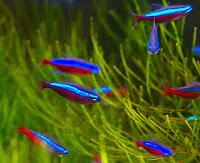Such is the beauty of these little jewel-like fish that when the first neon tetras became available to fishkeepers in the 1930s, they changed hands for the equivalent of a month’s pay.
 Some look for example the regular Mexican tetras; some are part of the method shaded and can see well; others appear to be identical as the dejected of vision give in fish. One of the most popular species is not kept for its color or its beauty, however, but as a zoological oddity. Occurringin a dark cave system in the San Luis de Potosi area of Mexico is a small, eyeless, pink-bodied fish known as the blind cave characin. Above the caverns exists a brilliant Mexican tetra of comparable size, which can see well.
Some look for example the regular Mexican tetras; some are part of the method shaded and can see well; others appear to be identical as the dejected of vision give in fish. One of the most popular species is not kept for its color or its beauty, however, but as a zoological oddity. Occurringin a dark cave system in the San Luis de Potosi area of Mexico is a small, eyeless, pink-bodied fish known as the blind cave characin. Above the caverns exists a brilliant Mexican tetra of comparable size, which can see well.A Life in the Dark
Infrequently, overwhelms move Mexican tetras from the currents above into a hole regarded as Cueva Chica. When this happens, these fish and the blind ones interbreed in the darkness, suggesting they are actually the same species. The results of such matings produce offspring with a range of features. Some look such as the typical Mexican tetras; some are part of the way shaded and can see well; others look much the same as the destitute of vision give in fish.
 Visionless give in characins are not dazzle when they incubate. Alternately, fattening stores and skin develop over their eyes, which could be of no utilization in the dullness. Tetras find their food and escape danger by detecting pressure changes nearby in the water. They do this using sensory canals that run along each side of the body.
Visionless give in characins are not dazzle when they incubate. Alternately, fattening stores and skin develop over their eyes, which could be of no utilization in the dullness. Tetras find their food and escape danger by detecting pressure changes nearby in the water. They do this using sensory canals that run along each side of the body.







0 comments:
Post a Comment